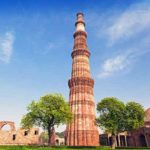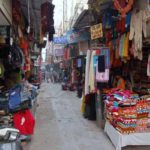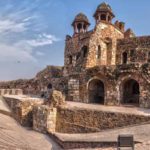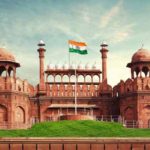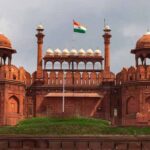Agrasen ki Baoli Delhi is a 60 meter long and 15 meter wide historical step well on Hailey Road near Connaught Place, New Delhi. Agarsen ki Baoli is a 14th Century Structure nested between the multi-storey buildings of Connaught Place. It is designated as protected monument by Archeological Survey of India (ASI). It is believed that this Baoli was originally built by the legendary king Agrasen during the Mahabharat epic era. Baoli is a Hindi word and it means a stepwell. Agarsen ki Baoli is being made to provide constant water supply to the city and a resting place for the travellers. Agarsen ki Baoli is also a water reservoir that is known for its heritage value.
Agrasen ki Baoli Delhi has unique structure which is quite different from the traditional round shape. It has three levels where each level has an arched area, which was used as a resting place. The center of the well has water and the water is also linked to a well dug in a covered platform. The gallery and chambers surrounded walls of Agarsen ki baoli are carved profusely. These chambers used to become cool and provide quiet retreats during summers.
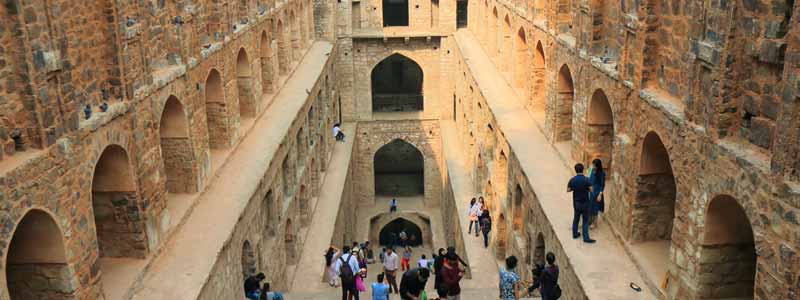
Agrasen ki Baoli: History
Agrasen Ki Baoli is one of the most important baolis of Delhi. Also known as Agrasen ki Baoli Delhi, the historical monument is being protected by the Archaeological Survey of India under the Ancient Monuments and Archaeological Sites and Remains Act of 1958. The baoli is 15-meter wide and 60-meter long.
There is no mention in the history as to who made the baoli; however, it is believed to have been built by King Agrasen. It is said that it was rebuilt in the 14th century by the Agaral community. The baoli now serves as a place of historical importance, a hang-out spot for family picnics and a destination for lovers in Delhi Tour Packages.
The word Baoli refers to a step well. Also known as Baodi or Bawdi, this kind of structure can frequently be found in the states of Rajasthan and Gujarat. Temple step wells and water temples were quite popular in ancient India. The step wells and reservoirs in places like Dholavira give a fair sense of the architectural patterns followed in the Indus Valley Civilisation.
The architecture of Agrasen ki Baoli Delhi is a rather interesting one and is one of its kind in Delhi. It has 108 steps that lead to the step well. The step well in Agrasen Ki Baoli is divided into three levels. All of these levels are lined with arched niches on both sides. These arches served as a meeting place and provided relief from the heat during summers. There are also passages to the rooms constructed in the baoli. However, the rooms are now locked for security reasons.
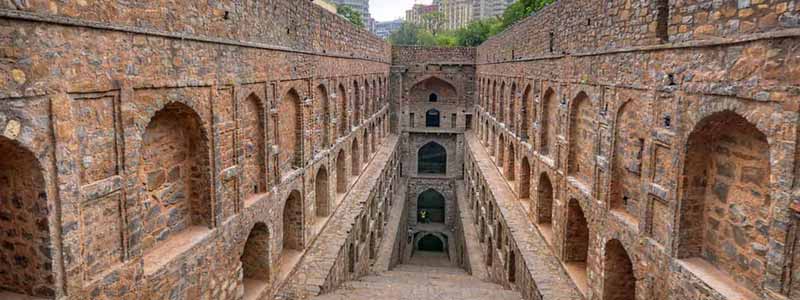
Agrasen ki Baoli Architecture
Agrasen ki Baoli Delhi, which is 60 meters in length and 15 meters in width, features a unique and ornate architectural style. The whole structure is built out of rubble masonry, using an assortment of rocks and stones. The rectangular shape of the stepwell makes it stand out from the other baolis in Delhi that were built as round water reservoirs. It spreads over three visible levels, each of which is adorned with beautiful and symmetrical arched niches that line on both sides.
Agrasen ki Baoli Delhi is among those few stepwells in Delhi that boast of a single-flight staircase. There are more than 100 steps that take you down to the water level and as you go down, you can experience a drop in temperature as well. A circular well exists at the northern end of this stepwell. It measures 8 meters in diameter and remains dry for the most part of the year. When it is filled with water in the monsoon season, the water level rises to a height of around 4 or 5 feet.
The well remains shielded with an iron grill that prevents anyone from intentionally or accidentally falling into the water. It is also linked by shafts to the rectangular passage. As the water level of the baoli rises, the passage also gets filled with water. A small mosque exists at the south-west corner of the Agrasen ki Baoli Delhi complex. A triple-arched entrance leads you to the mosque. These arches are supported by four sandstone pillars, one of which had collapsed long ago. These pillars are ornamented structures that add to the aesthetic beauty of the whole structure Delhi Monuments.
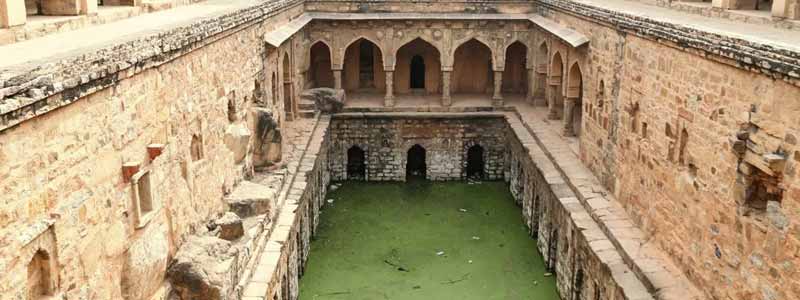
Places to visit Near Agrasen ki Baoli –
Many interesting places surround Agrasen ki Baoli Delhi, and there are plenty of things to do at Agrasen Ki Baoli. It would be best if you started from Connaught place, a vivacious place and one of the most busy places in Delhi Tourism. You will see the number of people hanging out here, and here you will find an endless number of restaurants, bazaars, shops to visit.
- Jantar Mantar
Jantar Mantar is located to the south of the Connaught circle in the parliament street. It is a huge observatory constructed to improve the knowledge of time and space in those times. Maharaja Jai Singh had built it in the year 1724.
- Humayun’s Tomb
The Humayun’s Tomb is the final resting place of the great Mughal Emperor Humayun. The best part of the tomb is its lush green and flourishing garden. It happens to be the very first garden-tomb of the Indian sub-continent.
The architecture of the Humayun’s Tomb has been greatly inspired by the Mughal and Persian structural design. The chief architect of the tomb was Mirak Mirza Ghiyath. It is also one of the featured monuments in the UNESCO’s heritage sites in the world.
- India Gate
The India Gate in New Delhi happens to be one of the most significant war memorials of the country. It is located along the Rajpath and offers an awe-inspiring sight. The structure is 42 meters tall and was designed by architect Sir Edwin Lutyens.
The monument pays homage to 72000 brave soldiers who were martyred in the First World War and the third Anglo Afghan war. It has 13300 inscribed names of servicemen on the walls. You will find the Amar Jawan Jyoti being lit all over the year to mark the immortality of the soldiers who lost their life for the nation.
- Kendriya Art Gallery
The Kendriya Art Gallery in New Delhi stands as a testimony for the fact that India is a country that has got the culture of art and crafts in its roots. The art gallery offers magnificent sights from various age-old paintings to many up to the minute modern artworks.
The museum is surely let you connect with the contemporary styles of artisans and various other passions of human beings. There are more than 14000 different exhibits and some of them are even close to 100 years old.
What is the Best Time to Visit Agrasen ki Baoli?
In the summer season, the temperature remains very hot, and because of the scorching heat, it is not possible to visit this kind of monument at this extreme temperature. So, the best time to visit Agrasen ki Baoli Delhi is from October to February. During the winter season, the weather remains cold and pleasant. People also love to visit these kinds of wonderful places at this time.
The Winter season is enjoyable, and it is considered the best time to Visit Agrasen ki Baoli Delhi with family and friends. There are many amazing places to visit in Delhi, but it comes at the list’s top. If you plan to visit Delhi, mark this place on your list to experience both adventure and history.
How To Reach Agrasen Ki Baoli?
Agrasen ki Baoli Delhi is situated on Halley Road in New Delhi, India, and the nearest metro station to go there is Janpath or Barakhamba Road. It is situated 2 km away from India Gate and 1.5 km away from Jantar Mantar.
By Train:- It is located almost 1 km far from the New Delhi railway station, and around 7 km away from Nizamuddin Railway station, you can take a bus, taxi, or auto to reach this place.
By Air:- Indra Gandhi international airport is the nearest airport in Delhi to reach Agrasen ki Baoli Delhi. It is around 14 km away from this place. From here, you can hire a cab, taxi, and auto rickshaws.
By Road:- Delhi is well connected with locals transports and the metro. As per your convenience, you choose anyone either local transport or metro both are easily available from every part of the city. In my opinion, the Delhi metro is far better than local transport because it is much safer, easily available, and has comfort and air conditioning.


